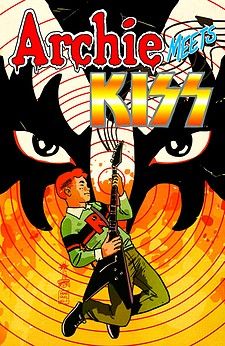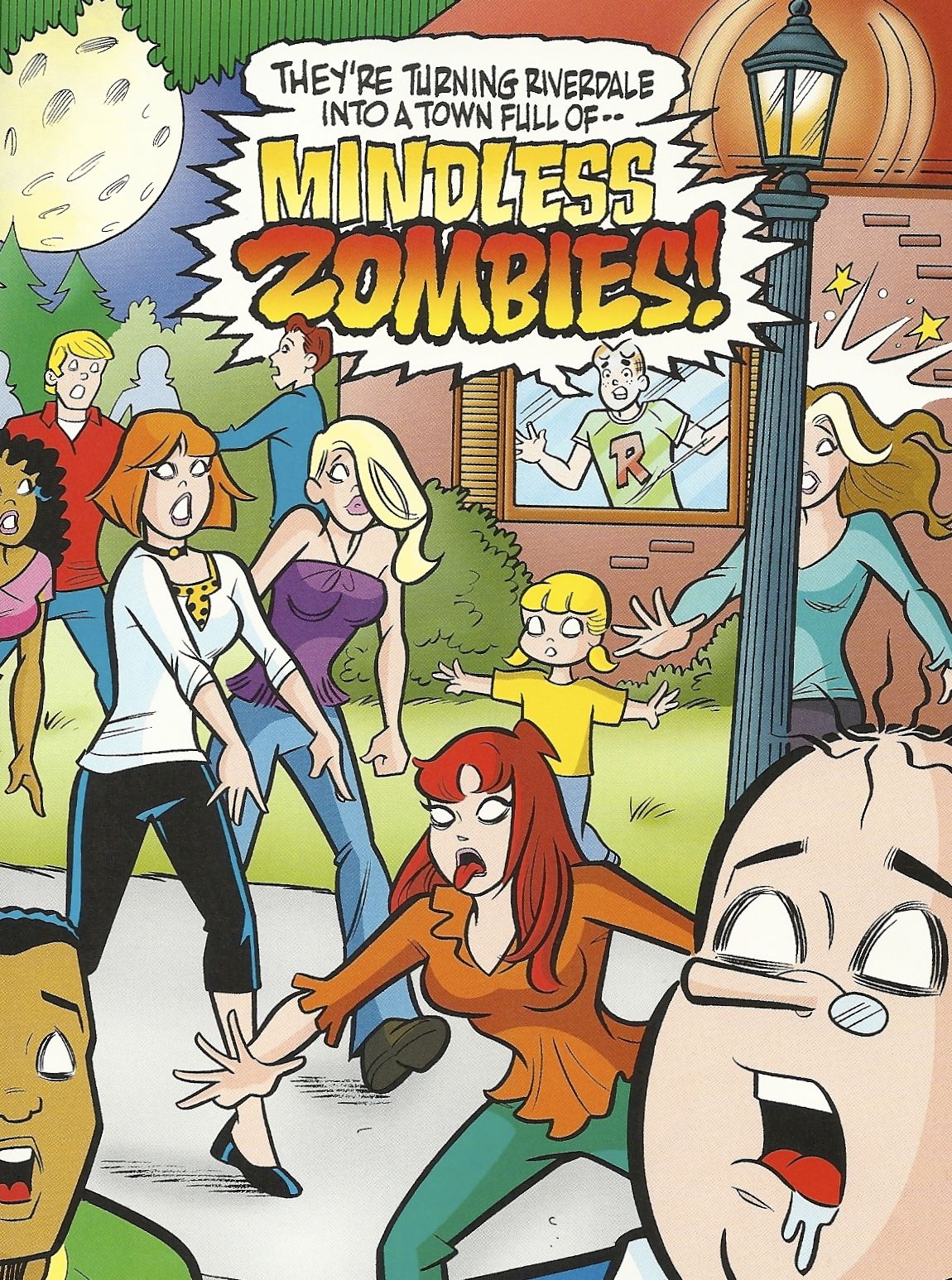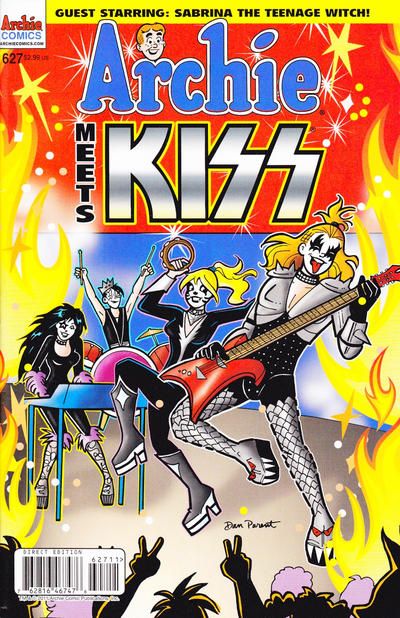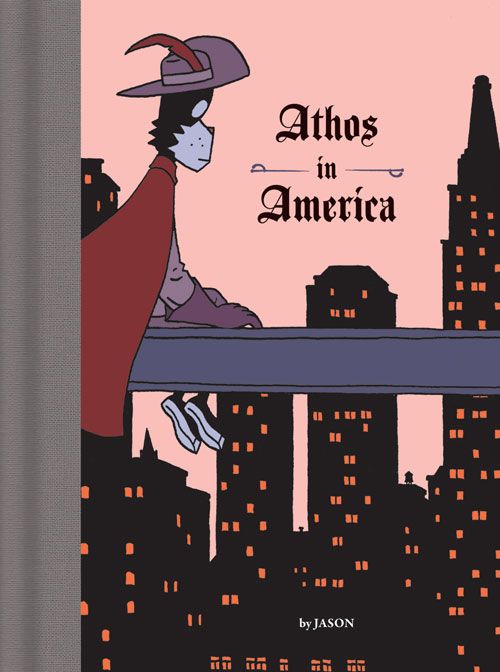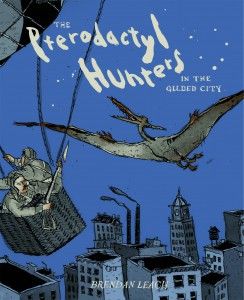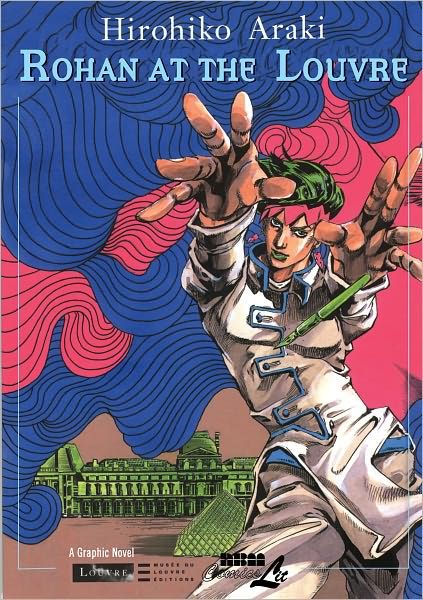Archie Meets Kiss (Archie Comics) Archie has proven especially adept at coming up with attention-grabbing — as in mainstream media attention-grabbing — storylines of late, and of all the “stunt” stories they’ve pulled off in the last few years, this one is by far the weirdest.
The closest thing I can think to which to compare it would be 1994’s Archie Meets The Punisher, although if that project worked by gleefully combining two funnybook polar opposites and letting that unlikely tension sell the book, having the eternal teenagers of Riverdale meet a rock band from the 1970s in the year 2012 is … well, it’s not so much the team-up you thought you’d never see, as it is the team-up no one could have imagined (except, I guess, for Gene Simmons, who apparently called up Archie Co-CEO Jon Goldwater and asked him to do the story).
Archie PR guy-turned-Archie writer Alex Segura and regular Archie artist Dan Parent (inked by Rich Koslowski) tell the tale: One night at a treehouse meeting of the Riverdale Monster Society, Sabrina (the Teenage Witch) is attempting to cast a protection spell over the city, but Veronica and Reggie accidentally mess it up, casting a projection spell that summons a quartet of monsters to town and, hot on their heels, Kiss.
The monsters—specific, teenage stereotype versions of the Universal monsters — set about sucking all of the fun out of Riverdale, threatening to make it an eternal land of lameness and tedium (Don’t worry, Segura makes the joke you yourself were just thinking of), and turning its residents into mindless zombies.
Kiss, who appear as their made-up, on-stage personas and are apparently here some form of monster-fighting rock band, try to defeat the monsters through the power of rock, but to do so, they will need an assist from the band The Archies. Various other Riverdalians appear, including Dilton, Sabrina’s talking cat Salem and Kevin Keller in substantial roles, while others get small cameos, like a zombified Josie (of the Pussycats) and Mr. Weatherbee.
The weirdness of the pairing never quite subsides, and Kiss’ presence in the comic remains unsettling. They are visiting Riverdale from another dimension, and at times Archie and his running crew seem to have no idea who they are, while at other times it seems as if Kiss is a known quantity.
I also had a hard time figuring out who the book was for. Like most modern Archie comics, the storytelling and sense of humor is apparently aimed at children (although some of Segura’s Jughead- and Reggie-delivered barbs are sharper than usual), but, well, there’s Kiss, and who knows or likes Kiss, really? I’m 35, and I don’t recall them being relevant at any point in my lifetime of pop-culture consumption; by the time I discovered rock music, they were just a joke band that people liked a decade or two previously.
Parent is a pretty great character designer, and I’ve long been impressed with his coloring book-style, Dan DeCarlo-inspired version of the Archie characters, and the way he’s Archie-iezed real people into the comics before, but the pages and panels are crazy loose in construction, often lacking backgrounds or even a sense of place or point of view, resulting in a jumble of figures (an effect exacerbated by scenes of flying characters in combat).
There are some pretty strong, slightly disturbing images though, as when Kiss disguise themselves in the Archie kids’ wardrobes to infiltrate the school, or when the Archie gang get kiss make-up at the climax.
This is a hard image to get out of your head, really:
And there are some super-swell images by Francesco Francavilla, who provided variant covers for the single issues.
I suspect the story probably read better in those single issues than it does in a collection. The hardcover collection, and all of the back matter and extras — including an introduction by Simmons, plenty of photos of the band, an article about a release party, Segura’s script for the first issue, tons of sketches, and an interview with the creators — furthers the expectation that this comic is truly something special, while it’s basically just your average Archie comic, albeit one with such a weird premise it belongs in the This Actually Happened pile of Archie stories.
Athos in America (Fantagraphics) This is another collection of graphic novellas and graphic short stories from master of deadpan presentation Jason in the style of Low Moon, and, as with the release of all new work from Jason, a cause for celebration.
The title story is a companion piece to 2008’s The Last Musketeer, once again featuring the unaging Musketeer who, unlike his peers, hasn’t given up on the whole Musketeering thing. Instead of an epic sci-fi adventure, however, this one features the character in an American bar, spilling his guts to the bartender and drunk-dialing his former brother-at-arms.
This book is chock-full of examples of Jason’s inspired appropriation of classic trash pop culture, and his repurposing of it in formally experimental (or is playful a better word?) explorations of the human experiment.
For example, there’s The Brain That Wouldn't Virgina Woolf, which is the plot of The Brain That Wouldn’t Die (a film of such quality an episode of Mystery Science Theater 3000 was built around it) as filtered through Who’s Afraid of Virginia Woolf?, or Tom Waits on the Moon, in which four overlapping stories unfold, one of them being the story of a mad scientist working on a teleportation machine that a fly gets into.
Jason’s comics are among the hardest in the world to review, as it’s difficult to say anything beyond “Well, that was perfect” in terms of assessment, and the specific magic he works is so difficult to describe in words, and so easy to communicate by simply pointing to a random volume of his work and saying, “Hey, check this out.”
So I guess these last few paragraphs are really just a roundabout way of saying Athos in America is perfect, and you should check it out.
The Pterodactyl Hunters in the Gilded City (Top Shelf Productions) Cartoonist Brendan Leach imagines a turn-of-the-century New York City — that’s turn of the 19th century into the 20th, not the more recent turn of the century — plagued by pterodactyls that snatch up human victims.
The city has responded with an agency dedicate to the extermination of the dinosaurs, and they nightly patrol the skies in hot air balloons, using dynamite and harpoon-mounted bombs. When the story opens, they’ve just about succeeded in ridding the city of pterodactyls, and there are but a couple left.
That’s just the backdrop for an intense family drama, involving two second-generation pterodactyl hunters, one a celebrity hero hunter whose name is always in the paper, the other his brother, who works in a pterodactyl watch tower and wilts in his brother’s shadow.
We follow them through a few particularly dramatic nights on the job, and Leach presents some quite equivocal events, including an open ending.
His artwork is as smart as it is gorgeous (you should really give it a look). The panel borders are hand-drawn and rough, the heavily cartooned character designs stray far from realism (while the script embraces realism save for its incorporation of long extinct flying reptiles), the slightly off-kilter lines vary in width and weight with a vital energy, the dialogue bubbles seem dashed-off, and he uses less-finished lettering and sketchy elements to imply things like a character deep in racing, muddle thoughts, or someone or something moving it’s head or limbs quickly.
It’s gorgeous, inspired work, and a powerful announcement of a creator I fully expect we’ll hear a lot from for a long time to come.
Also, it’s got pterodactyls in it, and if you’re anything like me, that’s all you need to know about a comic book.
Rohan at the Louvre (NBM) In mangaka Hirohiko Araki’s original graphic novel, produced in association with The Louvre, teenage wannabe mangaka Rohan meets a beautiful and mysterious young woman at his grandmother’s boarding house.
She discovers him drawing her one day, and suddenly opens up to him, relating a strange tale of a cursed painting created in Japan, made with a super-rare ink, the blackest ink ever discovered. The artist was put to death by the emperor and his work destroyed, save for a single painting he hid, which is currently tucked away beneath the Louvre.
A decade later, after Rohan has made it big in the world of manga, becoming something of a celebrity — there’s a neat scene where he signs his autograph so fast that his fans don’t even see his hand moving — and he journeys to Paris in search of the painting.
He finds it, to the woe of the handful of Louvre staff who accompany him to seek out the rare and mysterious work they didn’t even know they had in their possession.
It’s a somewhat slight work — I’ve just described the entirety of the plot, if none of its details — but it is a highly effective horror story, of the sort that will be familiar and welcome to fans of 21st century J-horror. Araki has a strong sense of design that leans hard and far away from the direction of what comes to the casual manga reader’s mind when they hear the word “manga,” and the panels are all big and rich in detail in a way that suggests European rather than Japanese comics art.
The most disturbing aspect of the book for me, however, had nothing to do with any of the deaths or disappearances and the imaginative ways they are effected. No, I couldn’t quite figure out what the heck was up with the weird, headband Rohan wears throughout the book — as both a 17-year-old and a 27-year-old — which you can see in pink on the cover. It’s some kind of cloth, upside down crown thing that encircles his forehead? It confuses me.
Showcase Presents: All-Star Squadron Vol. 1 (DC Comics) I love DC’s black-and-white, phone book-like Showcase Presents collections, which combine the pleasures of two very particular types of comics-purchasing experiences: that of finding a complete run of old comics in a discounted back-issue bin and acquiring something big, sturdy and durable for your bookshelf.
Of all of the volumes DC has released so far, this is the one I’ve most been looking forward to, as the 1981-1987 All-Star Squadron was one of the titles I’ve been trying to find in back-issue bins for years now, and have only managed to assemble bits and pieces of the Roy Thomas-written, World War II-set superhero series.
As longtime readers know, the premise of this series was to revisit the Golden Age of DC Comics during America’s involvement in World War II, which in 1981 meant the old "Earth-2" setting (not to be confused with their new Earth 2 setting), where all of the Golden Age characters DC had published (or had since acquired from defunct publishers) co-existed in one big, tightly interwoven shared universe, a la the Marvel Universe of the '60s.
As an exercise in pure world-building, it was an impressive, even fascinating endeavor, as Thomas took all of the pre-existing raw material from dozens upon dozens of 50-year-old comics from several publishers, and then started assembling them into one big epic that would itself be grafted onto real history. The ambition of the thing seems even more staggering in 2012 than it must have in 1981, perhaps because we've seen so many similar artificial attempts at universe-making in the years since. DC has rebooted its cosmology some half-dozen times since this series started, and it usually did so by throwing stuff out and starting over, rather than keeping everything and adding to it, as Thomas did.
That is, this story is real world events plus the stories published in the 1940s plus the stories Thomas weaved in, around and between them.
The premise has more immediate pleasures as well, including those of a superhero period piece and, at its core, the gee-whiz excitement of a gigantic team in which every superhero is a member (although it’s usually about a half-dozen heroes who make up the ensemble cast, while the other dozen or so are off doing their own things and/or serving in the U.S. military in their civilian identities).
This $20, 527-page collection includes the first 18 issues and an annual, and mainly stars Liberty Belle, Johnny Quick, Shining Knight, Firebrand II, Robot Man, Commander Steel, The Atom, The Hawks, Franklin Delano Roosevelt and Winston Churchill. The artwork, penciled by Rich Buckler and Adrian Gonzales in a DC house style, is clear, bold and emotive, although hardly inspired. Of course, given the steadily sliding quality of Big Two super-comic art, it looks like brilliant cartooning in comparison to much of what one might find on the stands today, and no doubt benefits from the black-and-white presentation, that frees the lines from the so-so coloring and printing quality of the early 80s.
My favorite part of the book is definitely the numeral 1 on the spine, though, as it implies a second volume, and hopefully more after that—there are still 49 issues of All-Star Squadron yet to collect, not to mention two more annuals and 31 issues of The Young All-Stars.


